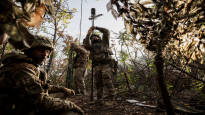The most interesting situation in the war in Ukraine is currently on the east bank of the Dnieper, where the Ukrainian troops have been able to bite in recent weeks, says the docent of military sciences Ilmari Käihkö.
The war situation has not changed much recently, but the front line has largely remained in place. Along the Dnieper, however, Ukraine has taken control of a long strip of the east bank of the river and has been able to cause difficulties for the Russians.
So far, Ukraine does not have very large forces on the eastern bank and only has a few individual vehicles there. For Käihkö, this is also a positive sign of Ukraine’s ability to continue fighting.
– There is potential here. Especially the fact that Ukraine is able to cause problems for Russia in this way. If problems can be created elsewhere, it can be good for Ukraine in the longer term, he says.
The military scientist is careful to call the territory occupied by Ukraine a bridgehead. In his opinion, the region is not so firmly under Ukraine’s control that it could still be used as a base for a wider attack.
Although the Ukrainian forces have been able to advance the war following map services such as Deepstatemaponly 2–4 kilometers from the river, it should be noted that the length of the occupied coastline is more than 30 kilometers.
The Ukrainians have crossed the bumpy banks of the Dnieper and are now reaching a region with a fairly dense population. Institute for the Study of War says, relying on Russian war bloggers, that Ukrainian forces are now fighting in several riverside villages, such as Krynky and Pidstepne.
New opportunities, but also a huge risk
In Ukraine, there has long been a wish that the army would cross the Dnieper and attack the Crimean peninsula directly.
Although the Dnieper is narrower than before after the destruction of the Kahovka dam, crossing the river with a large group would still be extremely risky.
– It is a risk, but in war you have to take risks, Käihkö states.
According to him, Ukraine must be able to break the current situation, where the front is stuck in place and the parties use up each other’s forces. The situation presumably benefits Russia.
Käihkö does not start drawing attack arrows on the map, but reminds that Russia has apparently not fortified the Kherson region very strongly. This would facilitate a breakthrough if one were to be attempted. Of course, the condition is that Ukraine has enough troops at its disposal.
Why doesn’t Russia hit the Ukrainians back?
Käihkö ponders why Russia has not succeeded in driving the Ukrainian troops back behind the river.
Russia is capable of shooting attackers with its artillery from afar. Käihkö also reminds us of the cruise bombs used by the Russian Air Force, which are practically impossible for Ukraine to repel. Large flying bombs use their wings to fly kilometers away and cause destruction.
Forbes magazine According to the report, the Ukrainian forces succeeded in crossing the river with the help of large-scale use of drones and signal jamming aimed at the Russians. According to the newspaper, the Ukrainians were able to use electronic interference to create a nearly 20-kilometer-wide zone where Russian drones could not operate.
It is also possible that Ukraine will not aim for a major attack, but will attack with smaller forces to wear down the Russian forces. News channel CNN Ukrainian general interviewed Oleksandr Tarnavsky says that with autumn, both sides are content to fight in small divisions of 10–15 men.
In the same article, the Chief of Staff of the British Armed Forces, Admiral Tony Radak too described Ukraine’s strategy with the words “strain, stretch and strike”. Ukraine makes attacks on Russian supplies, stretches the front and attacks when it sees fit – mostly with long-range weapons.
Bigger battle in Avdijivka
At the same time, Russia has tried to blockade the city of Avdijivka on the eastern front. There have been major battles on the north and south sides of the city. Russia has made some progress, but the conquest or siege of the city has not been successful.
Käihkö thinks the actions of the Russians are absurd. The Russian army has suffered huge equipment and crew losses without achieving any mentionable success. Hundreds of destroyed Russian armored vehicles are known.
– Russia repeats the same mistakes, they try to go through with the masses, Käihkö gasps.
– At some point, Ukraine was criticized for not trying the same in Zaporizhia. This is now a good example of not liking it, he continues.
Käihkö thinks that behind the attack in Avdijivka there is a political order from a high authority that some kind of victory must be achieved.
– In this case, the military commanders only do what they know how to do, i.e. send men in vehicles to attack over minefields.
